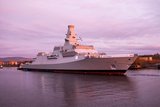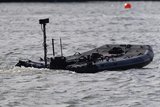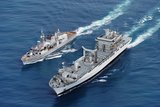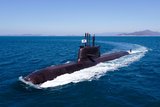Ford-class integrated combat system tested
The integrated combat system for the USS Gerald R Ford has undergone final developmental testing off the coast of California.
Carried out by Raytheon and the US Navy, the test saw the navy’s unmanned self defence test ship simulating a range of real-life scenarios, including a raid scenario exercise. Two anti-ship missile surrogate targets were located, classified, tracked and engaged using the Ship Self Defense System (SSDS) integrated combat system adapted for CVN 78.
SSDS is an open, distributed combat management system in service on US carriers and amphibious ships. SSDS is integrated with Raytheon's Cooperative Engagement Capability (CEC) for the extraction and distribution of sensor-derived information. This further enhances each ship's anti-air warfare capability through sharing of available data to all participating CEC units, improving situational awareness, increasing range, and enabling cooperative, multiple, or layered engagement strategies.
The SSDS ICS for CVN 78 has now successfully engaged three of three targets over the course of its first two test exercises.
Related Equipment in Defence Insight
More from Naval Warfare
-
![NATO naval exercises map out future USV requirements but raise questions on acquisition]()
NATO naval exercises map out future USV requirements but raise questions on acquisition
Uncrewed surface vessels have shifted from a desirable capability to a critical one for navies. But should these systems be bought outright, rented as a service or rapidly built using commercial off-the-shelf components?
-
![How will the Canadian Coast Guard’s transfer to the DND umbrella affect its capabilities?]()
How will the Canadian Coast Guard’s transfer to the DND umbrella affect its capabilities?
By joining the defence department, the coast guard will need to acquire new solutions and adapt its in-service capabilities to ensure interoperability with the Canadian Armed Forces.
-
![UK MoD’s confirmation of MBDA missile for Type 26 points to more European collaboration]()
UK MoD’s confirmation of MBDA missile for Type 26 points to more European collaboration
The Type 26 will also be fitted with the Sea Ceptor vertically launched air defence system that can fire CAMM missiles and a 24-cell Mk 41 vertical launch system that can fire the Tomahawk land-attack cruise missiles, anti-submarine rockets and long-range anti-ship missiles.
-
![Second Royal Canadian Navy Joint Support Ship is on schedule to be launched mid-2026]()
Second Royal Canadian Navy Joint Support Ship is on schedule to be launched mid-2026
While the first Joint Support Ship is currently in the final stages of outfitting, the second one is on schedule for launching next year.
-
![Is South Korea finally being taken seriously for Western submarine programmes?]()
Is South Korea finally being taken seriously for Western submarine programmes?
South Korean shipbuilders are beginning to make their mark beyond Asia, competing for major North American and European submarine programmes and becoming serious contenders on a global scale.























